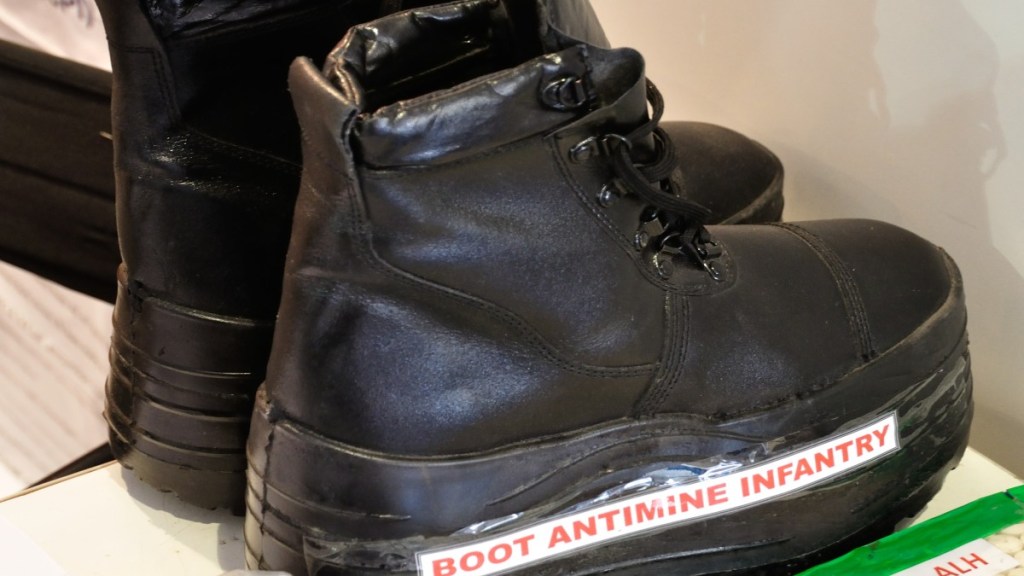The vast majority of anti-personnel mines across the globe are pressure mines, which are triggered to explode when the weight of a person is walking on top of them. Design and mathematics have established that the majority of the soldier’s weight should be distributed across a large portion of the shoe’s platform to avoid these mines. As a consequence of this, the pressure that is exerted per unit area drops to a level that is insufficient to trigger the bulk of the mines.
Despite the fact that many people around the world are striving for the total removal of anti-personnel mines, the number of mines still in existence has not decreased. In every armed conflict, thousands of anti-personnel mines are laid down, rendering not only military men but also civilians incapable of moving. The Treaty of Ottawa, which has been in effect for almost 30 years, did not actually have any effect on anything.
Under these conditions, there is just one course of action left to take, and that is to protect oneself from a mine as much as is humanly possible. This is especially true for infantry, who are responsible for work that is performed on a daily basis that is unnoticed yet is detailed and necessary.
As an efficient foot protection system against anti-personnel mine blasts, the Boot Anti Mine Infantry (BAMI) for assault operations has been devised by the Defence Research and Development Organisation (DRDO). It has a lower mass, which makes it easier to walk without experiencing weariness. Because chrome-tanned leather has the ability to both retain heat in the winter and release moisture and heat in the summer, this product offers the additional benefit of shielding the wearer’s foot from extremes of temperature.
An anti-personnel mine containing 35 grams of high explosive will produce a peak pressure of roughly 45,000 kg/cm2 when it detonates. This pressure will be generated by the mine’s explosion. If this level of pressure were to come into direct contact with the heel of a human, the bones in the leg would be completely shattered. The explosive overpressure is reduced by these Boot Anti Mine Infantry to a value that is less than 100 kg/cm2, which is a safe pressure that will be conveyed to the heel of the wearer. These Boot Anti Mine Infantry can resist the blast of a 35-gram CE (composite explosive) pellet, which has a weight that is comparable to that of a human. And, tests related to this were done by an independent lab. The largest amount of overpressure that may be transferred from these boots is, on average, less than one hundred kilograms per square centimeter.
The upper of this BAMI is made of chrome-tanned leather, which shields the wearer’s foot from the elements as well as the debris that can be generated by an anti-personnel mine explosion.
There are two different kinds of configurations for the heel (rear) side of the Boot Anti Mine Infantry sole, and there are two different kinds of configurations for the ball (front) side of the sole. Both combinations are possible. Deflectors made of fibre reinforced polymer (FRP) have been included in the design of the ball sides. Because of the plastic deformation and delamination of the FRP deflectors, some of the total blast energy that is provided to these FRP deflectors in the form of kinetic energy will be lost, and some of the remaining energy will be redirected toward the ground.
Ceramic honeycomb material has been inserted in between these FRP deflectors so that it can function as a stress-absorbing material. This material is available in a wide variety of different shapes that are designed to be a direct match to the contours of the FRP deflectors. The ceramic honeycomb material inserts are subjected to a process that involves crushing and grinding, which causes a considerable amount of the available energy to be used. Because of this, the user’s foot will receive transmission of a very minute amount of the energy released by the explosion of the anti-personnel mine. Consequently, the user will feel a slight feeling.
The ball (back) side configuration of the ball shape is made up of woollen felt and ceramic honeycomb material. This felt has a lighter overall weight and is more comfortable to wear because of it. The configurations on the ball side and the heel side of the foot have both been incorporated into the polyurethane sole of the shoe. The polyurethane material on the sole of this shoe is not only flexible but also wear-resistant.
Obviously, all such footwear is “strengthened” to neutralise pressure mines. These shoes are unlikely to safeguard the wearer from directed anti-personnel mines, which are activated by the operator’s command or a blown fuse. In spite of this, anti-mine shoes have prevented serious injuries to a number of soldiers, indicating that, albeit not always, they accomplish their purpose. As for the future, robotic mine-clearing equipment is experiencing rapid improvement, and their use will increase as time passes.
For the Indian Army
These special boots are for the soldiers in Northern as well as Eastern Command – deployed on the Line of Control (LOC) and also along the Line of Actual Control (LAC) in eastern Ladakh as well as in Arunachal Pradesh.

